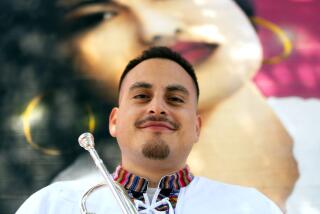PLAYING TAPS : With a Little High-Tech Help, Dancer Alfred Desio Makes Real Music on His Feet
- Share via
Have you checked out the toy catalogues lately? Slicker and heftier than some national magazines, they boast of a staggering array of electronic gizmos for children (batteries sold separately, of course).
Professional dancer Alfred Desio is wise to this. For the past decade, Desio has been at work on Tap-Tronics, an original performance style that blends classic tap-dancing with the audio effects made possible by modern technology.
Desio, who will strut his stuff Sunday in a Pacific Symphony family concert at the Orange County Performing Arts Center, says that his “Zapped Taps” are a perfect fit for a generation raised on radio-control toys and computer games.
“Many children are already familiar with the technology, although they may not realize it,” Desio said in a phone interview from his Los Angeles studio. “They’re aware that a radio signal can control a toy car, make it turn and go forward or backward.”
In his system, “a transmitter can take a tap sound and actually play a musical note or a drum sound,” he said. “Children see the use of technology in a different way, and perhaps open their minds to other possibilities.”
To get a rough idea of what Tap-Tronics is all about, imagine Fred Astaire dancing on the giant keyboard in the Tom Hanks film “Big.” Only there’s no keyboard. Desio’s music is generated by tiny electronic devices attached to the heels and toes of his tap shoes. When the devices strike the floor, they transmit signals to synthesizers, drum machines and special effects modules. The results can range from eerie to electric.
Part of Desio’s Costa Mesa performance will be danced to “Variations for Zapped Taps and Orchestra,” an original composition by Lucas Richman, Pacific Symphony assistant conductor from 1988 to 1991. Desio and Richman premiered the piece in a Pacific Symphony family concert in 1990 with Richman conducting. Edward Cumming, the current Pacific Symphony assistant conductor, will conduct Sunday’s concert, which will also feature Bartok’s Romanian Folk Dances, Dvorak’s Slavonic Dance and the fourth movement finale of Tchaikovsky’s Symphony No. 5. The program, the second in the orchestra’s six-concert Mervyn’s Musical Mornings series, is suggested for children ages 4 to 13.
Desio said he began work on the Tap-Tronics system in 1982 after doing a radio promotion for a dance festival.
“The radio engineer put my taps through a delay,” Desio said, and it was suddenly very obvious to me that if you could take that sound and then process and control it, you could create interesting rhythm ideas that were almost musical, rather than just the rat-a-tat tap sounds.”
Desio, a dancer since age 3 who has studied tap, ballet, modern and jazz, has rubbed elbows professionally with the likes of Jerome Robbins and Leonard Bernstein. He danced in the original Broadway production of “West Side Story” in 1957 (he played Luis, a Shark); 30 years later, he brought his Zapped Taps to an estimated 6,000 people in a performance for Lincoln Center Out of Doors.
In 1989, a version of Desio’s Tap-Tronics played to an even bigger audience when Gregory Hines performed it in the film “Tap.” (Desio, who acted as consultant “to make sure the tap shoes worked,” says he was pleased with the film but added that it offers a limited picture of his system’s capacities.)
Desio has taught dance to children and adults for years. Although he hasn’t been able to put Tap-Tronics into wide use in the classroom, he theorized that it could eventually be an effective teaching tool because of the way it enhances the dancer’s awareness of his or her movements.
On the few occasions he has been able to let children “put on the shoes and stomp around,” the response has been gratifying.
“If they can move rhythmically, and most of them can, they find they can play these notes and drums and they’re just elated,” Desio said. “They’re in control . . . it’s almost like composing.”
More to Read
The biggest entertainment stories
Get our big stories about Hollywood, film, television, music, arts, culture and more right in your inbox as soon as they publish.
You may occasionally receive promotional content from the Los Angeles Times.









